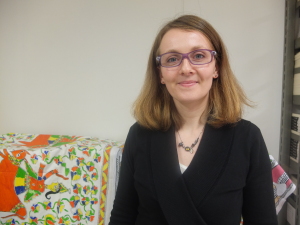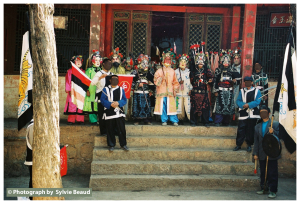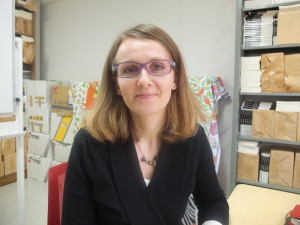Faculty Interview 36
Beaud ep. Kobayashi Sylvie
(Ph.D Candidate in Anthropology University of Paris Ouest Nauterre )

―― Would you tell me the subject of your research?
At the moment I’m writing my doctoral dissertation. So I would like to tell the outline of it. Well, I’m interested in the identity of “Han”, which stands for the majority population in China. Basically, when we say « the Chinese », we are talking about the Han, according to the contemporary categories. For understanding this topic, I started from the peculiar clothing of Han women in Yunnan province when I was a master student in Anthropology. I saw pictures that showed some women in Chengjiang district wearing minority-like’s clothes. In Yunnan province, there are many different ethnic groups who are defined by the State as recognizable by their specific clothing. Contrastively, Han people are always shown as “modern” or “westernized”. But in that book, the caption for these Chengjiang women in folk and embroidered clothes read that they were Han. I though it was very interesting. I showed these pictures to Chinese people in other places, France and China: from Beijing to Kunming, until I arrive to Chengjiang, and everyone I asked said that these ladies were not Han, but belonging to an ethnic minority. I finally found the place were the pictures were taken and talked to these ladies: they definitely regarded themselves as Han. So I started to research on the image of Han, and of course, on what they say about themselves.
―― So you have tried to understand what is Han and what is thought as “Han” through analyzing their clothing, haven’t you?
Actually, this theme was my master thesis. While conducting fieldwork research, I discovered that these clothes were no longer worn everyday by the young generations, but were used as drama costumes for festivals. On the New Year festival, I saw the local masked opera, called the Guan Suo Opera 關索劇. When talking about ethnicity with the local people, they always mentioned about the Guan Suo Opera, so I thought it might give some clues about what it means « to be Han » for them. So I focused on this Guan Suo Opera in my doctoral dissertation. Now I’m researching on how they perform, but also, more important, how they express their identity as Han through this masked opera.
―― As Han? I thought this kind of opera was the peculiar and traditional one based on each ethnic group’s own customs.
Yes and no. Masked operas of this kind can be found among both Han and minorities, but indeed they carry distinct local characteristics. In this opera, there are twenty characters. Guan Suo is one of them. This opera tells the story of the Romance of the Three Kingdoms『三国志演義』. It is not exactly the same as the novel, but many of the Guan Suo Opera’s characters can be found in the Romance as well, such as Guan Yu 關羽 for example. In fact, with this story, they are expressing their own local history and their identity. They don’t say they perform the Romance of the Three Kingdoms, but that they « play Guan Suo 玩關索». Guan Suo is not very famous character in general, but in Yunnan, and even in Southwest China, he is quite popular and worshiped as a god.

The argument that I’m trying to demonstrate in my doctoral dissertation is that the story of Guan Suo has been used as the model for retelling their history. It is thought that at the time of the Three Kingdoms (during the 3rd century), Guan Suo took part in the Southern campaign 南征 and came with an army to Yunnan to pacify the border of China. After that, sometimes Yunnan was ruled more closely by China’s central government, and at other times the region was cut from China. In the early time of the Ming dynasty, which began in the end of 14th century, there was another important campaign from the center of China to take a control of Yunnan. In the campaign of the Ming period and afterward, there was a policy to encourage the cult of Guan Suo, in a way to make people in Yunnan remember the time of the Three Kingdoms, namely when the Han Chinese took control of this area. To put it very simply, the central government tried to use the myth to legitimate his authority in the region. I think this way of retelling by the authorities of the present was used again several times in Chinese history. And besides I think the Guan Suo opera also tells the history of the way the local people have told who they are.
―― Has the story of Guan Suo been changing continuously according to the interpretations of Yunnan people in different periods?
I don’t really know about the history of the practice itself, but I believe there are some changes, because, you know, myths and stories vary with the needs of the each contemporary time. During the few years I observed the practice I saw some changes. But what remains is, I think, this process of retelling the story of Guan Suo as a model of the establishment of the garrisons in the region. My argument is that it’s not just a military operation, but it goes with telling myth and writing the history together with the people living there. In my impression, this process is typical of China and the Guan Suo opera tells one way in which people share a myth and a history and collaborating rituals.
―― Wow! “Sharing a myth” and “collaborating rituals” are very interesting perspectives! It was not one-way from the center to border, but the interactive.
Yes. The central government didn’t create this tradition from zero. That was already there. What the government did was to encourage, because it was useful, even necessary, for the government at that time when the Ming dynasty just began. They needed to destroy the former dynasty (which was still controlling Yunnan) and to include the people in new power. The myth and cult of Guan Suo would help the center to establish its authority there by reminding the local people of the time Guan Suo came to take control in the name of the Han kingdom of Shu. And besides, though the story of Guan Suo was a military operation, some populations in Yunnan keep a positive memory of the arrival of Zhuge Liang 諸葛亮(Kongming 孔明) the leader of the Southern Campaign. It is thought that he brought many good things to the area and civilized there.
And I think this way of using the myth to take control of the border area may have happened several times throughout Chinese history. The Guan Suo opera itself took shape in this region, during the 19th century along with another military settlement. The people whose ancestors came at that time also use the model of the establishment of the Ming dynasty. So this series can be considered as one referring to a former one, which is itself referring to another previous one…

―― How can you know the form of the Guan Suo opera in the Ming dynasty and 19th century?
No, I don’t know these things. I cannot tell about the actual form of the Guan Suo opera at the beginning. It is a discourse, namely what people say, how people express their own past that I want to know. I’m not a historian, but an anthropologist. I can only know what they say and what they are now doing. It’s not a historical fact, but the image of history.
―― They are making their own history by performing that opera!
Yes, exactly. Then we can back to the question of beginning, how they identify themselves as Han. They claim that they are Han because they perform the Guan Suo opera, which shows Guan Suo as a military general of the Han who founded their garrison/village, thus showing them as Han. Through researching more and more, I understood that the Guan Suo opera was talking about their history. On the surface, it’s telling about the Romance of the Three Kingdoms and the story of Guan Suo, but if you try to go deeply, you can understand this is their way to express their own history.
the interviewer’s postscript
I interviewed with Ms. Sylvie when she was concluding her doctoral dissertation. In this interview she told me her brand-new and original ideas. I was very excited by her fresh and dynamic perspectives. Thank you very much! (Tomoka MUSHIGA)

